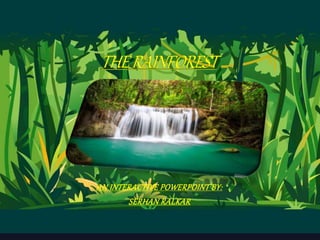THE RAINFOREST.pptx
•Download as PPTX, PDF•
2 likes•45 views
Rainforests cover less than 2% of the Earth's surface but are home to 50-70% of the planet's species. There are 4 layers in the rainforest: the emergent layer with the tallest trees up to 250 feet tall, the canopy layer that receives the most sunlight, the understory layer that receives only 2-5% sunlight, and the forest floor with poor soil and quick plant decay. Different plants and animals live in each successive layer of the rainforest ecosystem.
Report
Share
Report
Share

Recommended
Recommended
More Related Content
Similar to THE RAINFOREST.pptx
Similar to THE RAINFOREST.pptx (20)
Recently uploaded
Recently uploaded (20)
The Mariana Trench remarkable geological features on Earth.pptx

The Mariana Trench remarkable geological features on Earth.pptx
FAIRSpectra - Enabling the FAIRification of Analytical Science

FAIRSpectra - Enabling the FAIRification of Analytical Science
Information science research with large language models: between science and ...

Information science research with large language models: between science and ...
Major groups of bacteria: Spirochetes, Chlamydia, Rickettsia, nanobes, mycopl...

Major groups of bacteria: Spirochetes, Chlamydia, Rickettsia, nanobes, mycopl...
Adaptive Restore algorithm & importance Monte Carlo

Adaptive Restore algorithm & importance Monte Carlo
Understanding Partial Differential Equations: Types and Solution Methods

Understanding Partial Differential Equations: Types and Solution Methods
LUNULARIA -features, morphology, anatomy ,reproduction etc.

LUNULARIA -features, morphology, anatomy ,reproduction etc.
Fourth quarter science 9-Kinetic-and-Potential-Energy.pptx

Fourth quarter science 9-Kinetic-and-Potential-Energy.pptx
GBSN - Biochemistry (Unit 2) Basic concept of organic chemistry 

GBSN - Biochemistry (Unit 2) Basic concept of organic chemistry
Selaginella: features, morphology ,anatomy and reproduction.

Selaginella: features, morphology ,anatomy and reproduction.
TransientOffsetin14CAftertheCarringtonEventRecordedbyPolarTreeRings

TransientOffsetin14CAftertheCarringtonEventRecordedbyPolarTreeRings
Porella : features, morphology, anatomy, reproduction etc.

Porella : features, morphology, anatomy, reproduction etc.
THE RAINFOREST.pptx
- 1. AN INTERACTIVE POWERPOINT BY: SERHAN RALKAR
- 2. 1. Specific Description 2. Layers of the Rainforest
- 3. Rainforests cover less than two percent of the Earth’s surface, yet they are home to some 50 to 70 percent of all life forms on our planet. The rainforests are quite simply, the richest, oldest, most productive and most complex ecosystems on Earth.
- 4. There are 4 layers in the rainforest. - Emergent Layer - Canopy Layer -Understory Layer -Forest Floor Different animals and plants at each level
- 5. Tallest layer More sun than any other layer Made up of tall, wide trees - Trees from 130 to 250 feet tall - Trees have waxy leaves Very windy and very warm
- 6. Primary layer of rainforest Rises to 150 feet Thick, woody vines called lianas found in this layer Plants grow on the trees - Use water and sun unique to canopy layer - Orchids, lichens, ferns, mosses
- 7. Receives only 2-5% of sunlight available to the canopy Made up of vines, smaller trees, ferns and palms and small bushes Poor soil with few nutrients for plants
- 8. Very dark Almost no plant life Decay happens very quickly Lots of large tree roots Many large animals, frogs, and insects